Our first in a new series of interviews with ‘Young Scientists’
After a semester studying marine biology at Moss Landing Marine Labs, Liz McHuron headed off to the little-known nation of Suriname to monitor leatherback sea turtles. Her responsibilities included implementing a conservation strategy for a particular beach, moving leatherback nests in danger of flooding, and educating volunteer workers on the biology, behavior, and conservation efforts of the world’s largest, and most unique, marine turtle.
I visited McHuron during her time at the beach of Galibi in Suriname; she proved to be the sort of scientist who refused to be deterred: breathtaking humidity or downpours, fer-de-lances on the beach or jaguars, Liz was always on the move, always working to aid the critically-endangered leatherbacks while studying them with the thoroughness inherit in a born scientist.
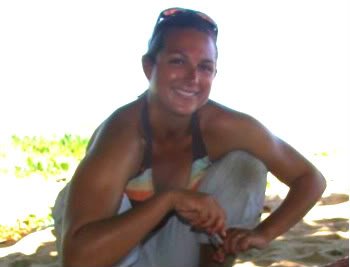 Liz McHuron on Galibi beach in Suriname. |
McHuron grew up in the Midwestern state of Minnesota, as she says “probably about as far as you can in US” from the ocean, however she spent summers on Florida’s coasts, which began her journey to marine biology. While her career path is “competitive” and “requires a lot of work and determination” McHuron wouldn’t have it any other way. Despite the large numbers of people drawn to marine biology, McHuron advises that if it’s what you want to do than you should do it.
In her interview, McHuron emphasizes the unique qualities of leatherbacks, by pointing out that not only are they the largest marine turtle species in the world, they also travel the furthest: “they migrate thousands of kilometers from foraging grounds to nesting sites”. For example one individual has been clocked traveling from Indonesia to Oregon in a single year.
Noting that the leatherback is critically endangered with most of its population remaining in the Atlantic, McHuron outlines the major threats to the species as “incidental (unintentional) catches by industrial fisheries and destruction of coastal nesting habitats. Leatherbacks also face threats from ingestion of plastic bags (they look a lot like a jellyfish when floating in the water), and poaching and harvesting of eggs and adults.”
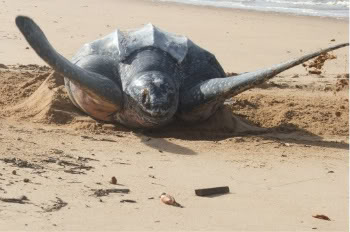 After laying her eggs a leatherback mother will camouflage her nest. With big bold strokes of her front slippers she disturbs the entire area around the nest to confuse predators. Photo by Liz McHuron. |
During her time in Suriname, McHuron moved leatherback nests to her hatchery whenever they were laid so low on the beach that they could be threatened by a high tide. She believes her project was a success: “The majority of the nests that were moved to that hatchery did hatch, and I felt this was a good result given the overall low hatch success of leatherback nests…I believe the project improved the overall odds of survival on the beach, especially considering the nests in the hatchery would have never hatched in the wild because they would have been flooded by high-tides.
McHuron says that one doesn’t need to be a scientist to help preserve the leatherback and other marine species. “I think that educating yourself is one of the best, and easiest, ways to help.” She adds that anyone can become “conscientious about where our food comes from and how it is processed… Lots of grocery stores now advertise how fish were caught, and Seafood Watch provides a great brochure of the best and worst types of seafood to purchase.”
McHuron hopes to return to Suriname and continue her work with the Leatherback Sea Turtles, but cautions “only time will tell”. Whatever path McHuron pursues in her future studies and career, one can be assured it will be worth following.
McHuron discussed studying marine biology, working with leatherback turtles, and living in Suriname in a January 2009 interview with mongabay.com, a leading conservation and environmental science news site.
YOUNG SCIENTIST PROFILE
Mongabay: Growing up in Minnesota–nowhere near an ocean–how did you become interested in being a marine biologist?
Liz McHuron: Even though I grew up so far away from the ocean (probably about as far you can get in the US), I spent a fair amount of time near the ocean. My first exposure to the ocean was at 6 weeks when my family took a vacation to Bermuda. My parents said I was probably the only 6 week old baby with a tan, and looking at me now, that’s not much of a surprise. My grandparents, and later my mother, lived along the East coast of Florida, and I spent entire summers practically living on the beach. The time that I spent in Florida was really what sparked my interest in marine biology.
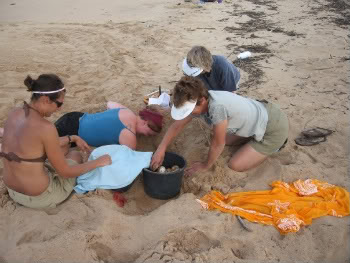 Liz McHuron works wirh volunteers on digging up a nest to be moved to the hatchery. Photo by Jeremy Hance. |
Mongabay: What advice would you have for an undergraduate who plans to apply to graduate programs in marine biology?
Liz McHuron: There are two pieces of advice that I would give undergraduate students that are thinking about applying to graduate programs in marine biology. The first one is that, as much as we might hate the system, you have to do well in school. Many graduate programs have a minimum GPA requirement, and if you don’t meet that, you won’t even be considered for acceptance. The second piece of advice is to get out and get research experience, and the best time to do this is when you are an undergraduate. Undergraduates have access to programs and research opportunities through their university, and there are also a lot of summer research programs that are specifically designed for undergraduates. Getting research experience not only makes you a more qualified graduate school applicant, but it also allows students to find out what areas of research they are interested in.
Mongabay: A lot of kids are interested in marine animals, what should they know about the field before pursuing marine biology as a career?
Liz McHuron: I think that your question pretty much sums it up, a lot of kids are interested in marine animals (specifically mammals), which makes it a highly competitive field. That said, I don’t think this fact alone should deter anyone from pursuing marine biology as a career. The one thing to keep in mind is that any job in this field is going to require a lot of work and determination, and that in most cases, a bachelors degree is not going to be enough. The other thing to think about is that there are a lot different types of jobs that might fall under the heading of marine biology. Some people do field research, teach at high school, community college or university level, or do both. I think it’s important for students to find out what types of jobs are out there, what they are most interested in, and the types of experience and education associated with the jobs that they are interested in.
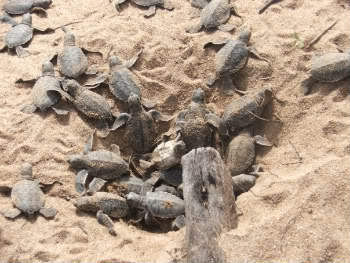 A nest of green sea turtles, another species prevalent on the island, hatches. The baby turtles scramble out of the nest and move as quickly as possible to the ocean to avoid predation. Photo by Liz McHuron. |
Mongabay: What are some of your favorite species to work with?
Liz McHuron: I haven’t really had the opportunity to work with that many marine mammal species, so my choices are limited to leatherbacks, harbor seals, and the occasional sea lion and elephant seal.
Out of those, I would have to say that harbor seals are my favorite. I couldn’t tell you exactly why they’re my favorite…maybe it is because my first research opportunity was with harbor seals. When I was an undergraduate I also did a research project on sea cucumbers and they are pretty cool too!
Mongabay: Do you have a favorite place to see marine wildlife?
Liz McHuron: My two favorite places to see marine wildlife are Monterey Bay and the San Juan Islands. There is such a plethora of marine wildlife in these two areas, and both are very accessible to the public and cheap! Of course I’m biased since those are pretty much my two favorite places in the US in general.
LEATHERBACK SEA TURTLES
Mongabay: What makes leatherback sea turtles different from other marine turtles?
Liz McHuron: There a lot of things that make leatherbacks different from other marine turtles, but the two that stand out the most to me are their size and the fact that they migrate thousands of kilometers from foraging grounds to nesting sites. Leatherbacks are the largest of the seven species of sea turtles and can reach up to 2 meters in length. They nest on tropical and subtropical beaches in the Atlantic and Pacific, and then travel to high latitudes where there are cold and productive waters (lots of good things to eat). You can check out the movements of Pacific leatherbacks at http://www.greatturtlerace.com/. This website also has a lot of great facts and other videos about leatherbacks.
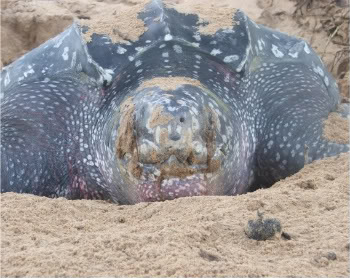 Close-up of a leatherback marine turtle. Photo by Liz McHuron. |
Mongabay: What is the current state of leatherback populations worldwide?
Liz McHuron: The leatherback is currently classified as “critically endangered” by the Species Survival Commission of the International Union for the Conservation of Nature (often abbreviated the IUCN). Check out their website http://www.iucnredlist.org/ for the criteria used to classify a species as “critically endangered.” There has been a dramatic decline in the nesting populations of leatherbacks in the Pacific Ocean in the last two decades, and about 70% of the world population of leatherbacks resides in the Atlantic Ocean.
Mongabay: What are the particular threats to leatherbacks?
Liz McHuron: The major threats to adult leatherbacks include incidental (unintentional) catches by industrial fisheries and destruction of coastal nesting habitats. Leatherbacks also face threats from ingestion of plastic bags (they look a lot like a jellyfish when floating in the water), and poaching and harvesting of eggs and adults.
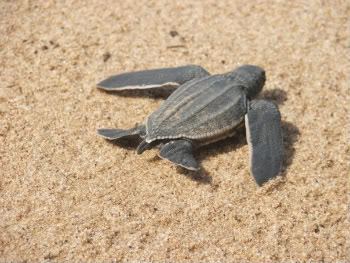 A leathback hatchling can fit in the palm of your hand, but adult leatherbacks can weigh 700 kilograms (approximately 1500 pounds). Photo by Liz McHuron. |
Mongabay: Can you tell us about your conservation project with the Oceanic Society? What were your responsibilities?
Liz McHuron: The Oceanic Society is a non-profit organization whose primary mission is to protect endangered wildlife and preserve threatened marine habitats worldwide. In Suriname, the primary goals for this project were to help reduce poaching and to increase leatherback hatchling success. As an intern with the Oceanic Society, I was responsible for helping to make sure that these goals were met, and to work with Oceanic Society volunteers that came to help out with the project. The beach that I lived on is approximately 6 km long, but I was only responsible for monitoring a small portion of that. At least once a night, sometimes two depending on the tide, I patrolled the beach looking for leatherbacks. Leatherbacks that were found nesting were measured and scanned for PIT tags. Nests that were laid too close to the water line and in danger of being flooded were moved to a hatchery.
Mongabay: How successful do you feel the project was?
Liz McHuron: Overall I think that the project was a success. The majority of the nests that were moved to that hatchery did hatch, and I felt this was a good result given the overall low hatch success of leatherback nests. I also recorded the percentage of eggs hatched in each nest. While worldwide about 50 percent of leatherback eggs actually hatch, that percentage is lower in the Galibi area. In the hatchery 30 percent of the eggs hatched which was consistent with previously published results from the natural nests in the area. I was very pleased to see that the nests in the hatchery did as well as those in the wild. I believe the project improved the overall odds of survival on the beach, especially considering the nests in the hatchery would have never hatched in the wild because they would have been flooded by high-tides.
There also were four volunteer groups that came down to help out with the project, and I think each volunteer left with a better understanding of sea turtle biology, the threats facing leatherbacks, and a first hand look at what field research can be like. For me I think that the opportunity to work with these volunteers was one of the highlights of my trip, and I still keep in touch with some of them. As far as the goal of reducing poaching, I couldn’t really say if it was successful or not because this was my first time down there. The presence of researchers can be a deterrent to poaching, but at the same time the beach is quite large and we can’t be everywhere at one time. I can say that I did see quite a few nests that had been poached, and I think that the issue of poaching is far from resolved at that particular beach.
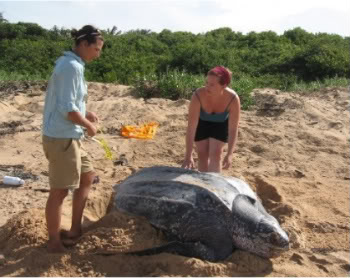 Liz McHuron and volunteer Tiffany Roufs begin gathering information about a mother laying her eggs. The leatherback turtle enters a kind of trance while laying, allowing scientists to approach them in relative safety. Photo by Jeremy Hance. |
Mongabay: What can the general public do to help leatherbacks and other marine turtles?
Liz McHuron: I think that educating yourself is one of the best, and easiest, ways to help. There are a lot of small choices that people can make in their everyday life that can help the environment. Recycling and reducing waste, using environmentally friendly cleaning products, shampoos, etc. are a few really easy ways to help the environment. Being conscientious about where our food comes from and how it is processed, etc. is also an easy way to help the environment. Lots of grocery stores now advertise how fish were caught, and Seafood Watch provides a great brochure of the best and worst types of seafood to purchase.
SURINAME
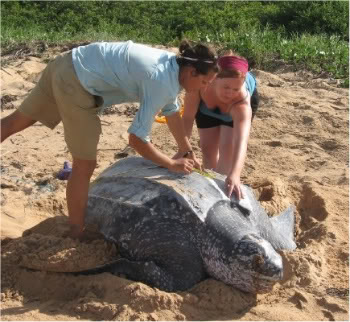 Liz McHuron and volunteer Tiffany Roufs measure the leatherback’s carapace. Photo by Jeremy Hance. |
Mongabay: Suriname is a little known South American nation with a wealth of biological richness, what was your impression of the small nation after spending a summer there?
Liz McHuron: When I first left for Suriname I wasn’t really sure what to expect. It is very difficult to find any information about it, except for maybe a few pages in a South American travel guide. I remember taking my first trip down the Marowijne river on our way out to Galibi, and thinking that this was exactly what I would picture the rivers and jungles of South America to look like. While it was beautiful, it was really sad for me to see the amount of trash in the river and on the beaches. It’s a harsh reminder that there are very few places, if any, that modern civilization hasn’t touched. As for culture, I feel like it’s almost something that can’t be described. The demography is such a mix (Dutch, Indian, Creole, several native groups, etc) that it is really difficult to pinpoint one culture that would describe most Surinamers. I also think that the culture is changing as more and more people move to the capital city of Paramaribo and become more modernized.
Overall I think that Suriname is a very unique country with lots of great wildlife and beautiful nature, but I think like most developing countries, it’s still struggling to deal with some of the downsides of modern civilization.
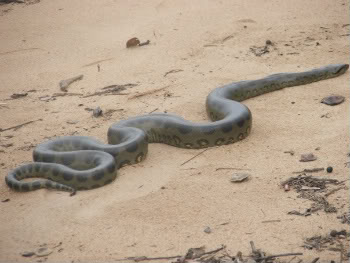 An anaconda on the beach. Bordered by tropical forest Galibi beach was also home to jaguars, tarantulas, and squirrel monkeys. Photo by Liz McHuron. |
Mongabay: You were also the tour guide to English-speaking tourists visiting the Galibi beaches. What role do you think tourism can play in educating the public about the importance of conservation initiatives? Were you surprised by the number/type of tourists that visited Galibi?
Liz McHuron: I think that tourism plays an important role in educating the public, and it also generates money, which can help in motivating countries to protect species such as leatherbacks. I think that a lot of tourists that visited Galibi came away with a great respect for leatherbacks and the problems facing this species, and hopefully they will spread the word! While there are a lot of positive effects from tourism, it also can have negative effects. Tour guides need to make sure that tourists refrain from disturbing the turtles while they are nesting, and this can be a difficult task. As for being surprised by the number/type of tourists, I was surprised by the number of Dutch people that vacation there. While Suriname was a Dutch colony (the national language is still Dutch), I wasn’t prepared for the amount of Dutch tourists and students that intern in the capital.
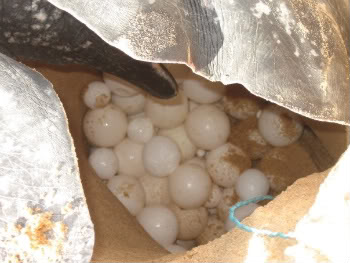 Leatherback eggs. Photo by Tiffany Roufs. |
Mongabay: Would you recommend Suriname, and Galibi specifically, as a good place for people to see leatherbacks and other marine turtles? Why or why not?
Liz McHuron: Yes and no. I think that Suriname and its nesting beaches are a great place for people to see leatherback and green sea turtles. The nesting beaches in Suriname and French Guiana support approximately 40% of the worlds nesting leatherbacks, which means that there is a very good chance of seeing a leatherback. The downside is that Suriname is relatively inaccessible to people traveling from the United States, and can be expensive and difficult to get around once you are there.
Mongabay: Any favorite memories from your time on the beach studying leatherbacks?
Liz McHuron: Since I spent most of the time by myself, all of my favorite memories are when there were actually people to interact with. I think my favorite memories were from when the last group of Oceanic volunteers came. They were so enthusiastic about learning about leatherbacks, and really got to see firsthand what my life was like down there. I think that some of my science geekiness rubbed off on them too! I am willing to bet that under no other circumstances would Tiffany, a volunteer, be willing to “dress up” as a leatherback and be videotaped.
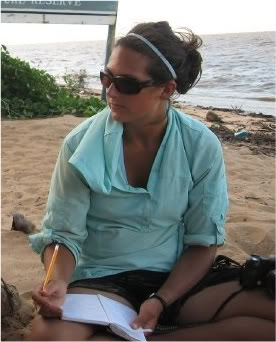 A rare moment of Liz sitting on the beach. Photo by Tiffany Roufs. |
Mongabay: Do you think you may return to Suriname to work with marine turtles again?
Liz McHuron: I hope so, but you just never know. I am currently working on designing a thesis project on leatherbacks in that area, but I’m just in the beginning stages. Working in an area that is as remote as Suriname is great in a lot of respects, but also is difficult from a logistical standpoint. I guess only time will tell…
Previous articles
“Turtle carbon” could help protect rainforests and save endangered sea turtles
(08/12/2008)
Scientists have discovered a new migration route for the world’s largest turtle, the leatherback. The route takes the 2,000-pound marine turtle from the Playa Grande beaches in Costa Rica to an area deep in the South Pacific.
Discovery of new leatherback migration route may help save species
(07/15/2008)
Scientists have discovered a new migration route for the world’s largest turtle, the leatherback. The route takes the 2,000-pound marine turtle from the Playa Grande beaches in Costa Rica to an area deep in the South Pacific.
Volunteering with Leatherback Sea Turtles in Galibi, Suriname
(07/08/2008)
The northern coast of Suriname is one of the best places in the world to view the largest turtle, the marine Leatherback. Watching the turtle rise out of the tides onto the beach gives one the sense of meeting something ancient, rare, and more sea-monster than marine turtle. Yet, if I call it a sea-monster, I do not mean that it is frightening or ugly: far from it. But it is mysterious, terrible, and wondrous.







